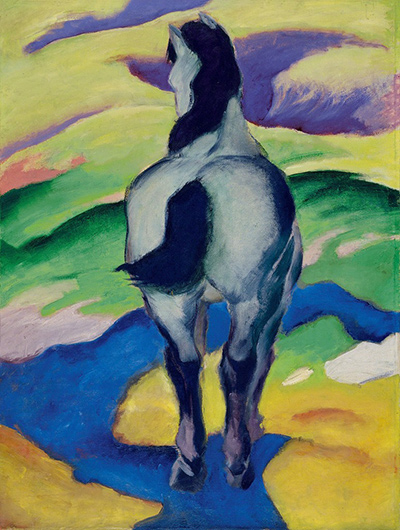The painting represents a single vividly coloured Blue Horse against a mixed background of primary colours; yellow and blue and secondary colours; purple and green.
There are also splashes of white and a spontaneous splash of a peach in the left upper quadrant of the painting.
The Blue Horse has been depicted in such a way that the observer can only see the rear hindquarters of the Horse, the croup, the hocks of the hind legs and the back of front right leg.
The front left leg is partially obscured by the hind legs. The position of the crest of the Blue Horse would suggest that the Horse is looking down and to the left of the background away from the observer.
Comparing the Blue Horse II painting to another one of Marc’s paintings Blue Horse I would seem to suggest that it was the same horse being depicted in both paintings but that Blue Horse II was the rear view of Blue Horse I.
The Blue Horse II painting is part of a series of horse portraits by Franz Marc that are represented in a similar style of which the following belong to: Blaues Pferd I 1911, Big Blue Horses, Blue Horse I, Blue Horses, The Large Blue Horses 1911 to name a few.
The significance of colour is important to fully understanding and appreciating Marc’s paintings due to the way he utilizes it to convey moods. In fact, specific theories about colour had been developed by Marc such as associating blue with masculinity, yellow with femininity and red with physical energy; most usually of a violent nature.
Blue, which is a salient theme in this painting could be construed as a nod to the impressionist group Der Blaue Reiter which he founded in 1911 alongside fellow artist Wassily Kandinksy. Der Blaue Reiter emphasizes the use of bold colours and elements of the cubist movement which is evident in Franz Marc paintings.




